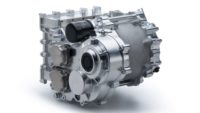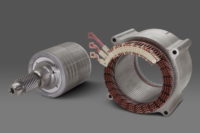ZF Unveils Compact Magnet-Free Electric Motor

FRIEDRICHSHAFEN, Germany—ZF has developed an electric motor that does not require magnets. The I2SM (In-Rotor Inductive-Excited Synchronous Motor) transmits energy for the magnetic field via an inductive exciter inside the rotor shaft. This makes the motor compact, with maximum power and torque density.
This advanced variant of a separately excited synchronous motor is an alternative to permanent-magnet synchronous machines (PSM). The latter are currently the motors most frequently used in electric vehicles, but they are based on magnets that require rare-earth materials for their production.
“With this magnet-free e-motor without rare earth materials, we have another innovation with which we are consistently improving our electric drive portfolio to create even more sustainable, efficient and resource-saving mobility,” says Holger Klein, Ph.D., CEO of ZF. “This is our guiding principle for all new products.”
Compared to traditional common separately excited synchronous motor (SESM) systems, the inductive exciter can reduce losses for the energy transmission into the rotor by 15 percent. In addition, Klein claims that the CO2 footprint in production, which arises with PSM e-motors due to magnets including rare earth materials, can be reduced by up to 50 percent.
In addition to the benefits of eliminating rare earth materials in a compact and powerful package, the I2SM eliminates the drag losses created in traditional PSM e-motors. This enables better efficiency at certain operating points, such as long highway trips at high speed.
“To ensure that the magnetic field in the rotor is built up by current instead of magnets, the conventional SESM concepts currently still require sliding or brush elements in most cases, which force compromises,” explains Klein. “A dry installation space, [which is] not accessible for oil cooling and with additional seals, is necessary.
“As a result, conventional SESMs take up around 90 millimeters more space axially,” Klein points out. “Manufacturers generally cannot flexibly vary between PSM and SESM variants in their model planning without additional effort.”
ZF engineers compensated for the design-related disadvantages of common separately excited synchronous machines. In particular, torque density has been significantly increased with an innovative rotor design. The space-neutral integration of the exciter into the rotor means that there are no axial space disadvantages. In addition, an increase in power density in the rotor leads to an improvement in performance.
Energy is transferred inductively, without mechanical contact, into the rotor, generating a magnetic field by means of coils. As a result, the I2SM does not require any brush elements or slip rings. And, there is no longer any need to keep this area dry by means of seals. As with permanently magnetized synchronous motors, the rotor is efficiently cooled by circulating oil.
ZF plans to mass-product 400- and 800-volt versions of the motor for use in passenger vehicles and trucks.
Looking for a reprint of this article?
From high-res PDFs to custom plaques, order your copy today!






